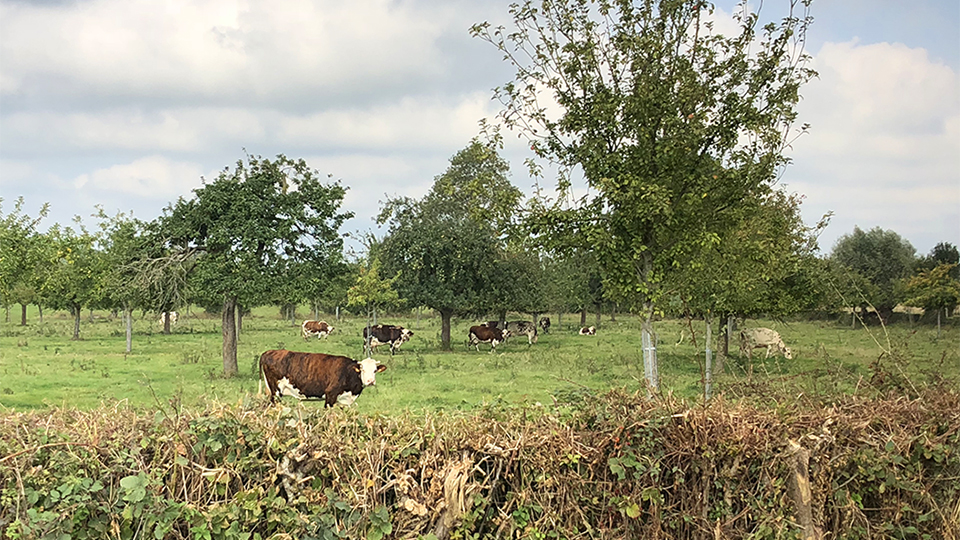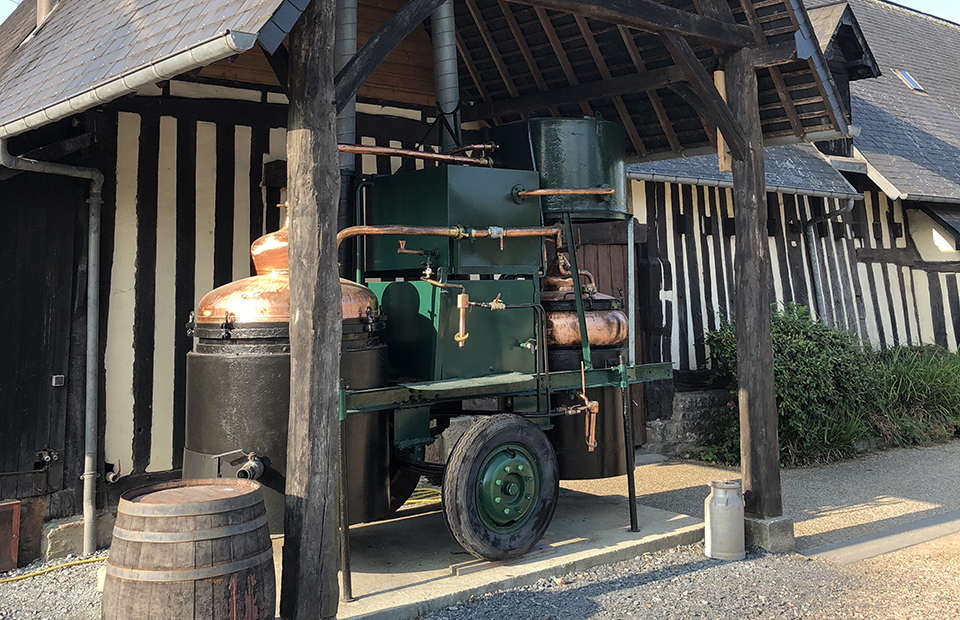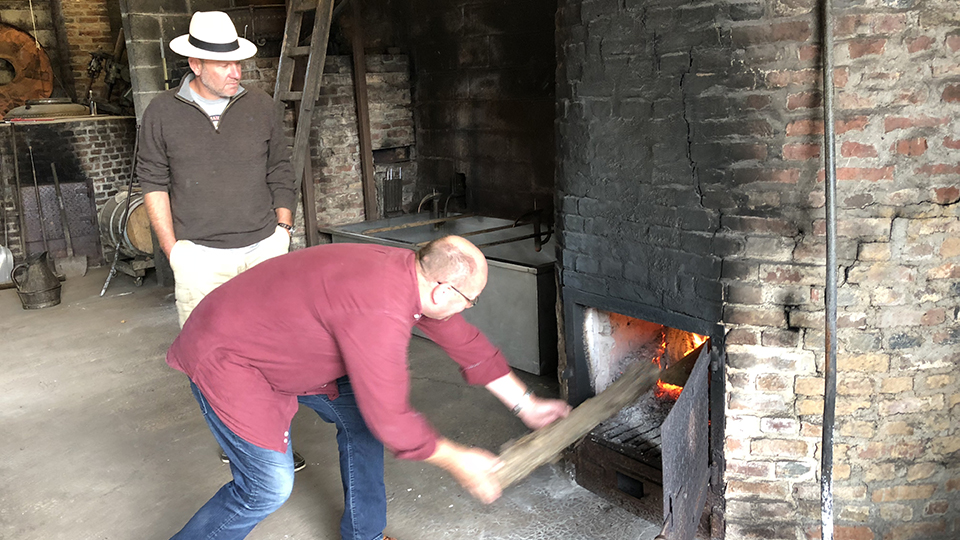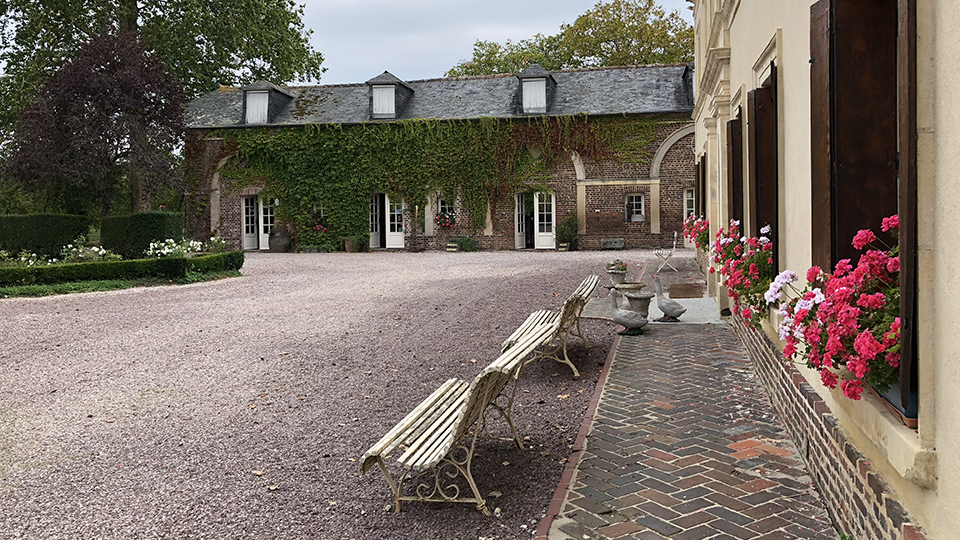Browse using the new Vinous website now. Launch →
Printed by, and for the sole use of . All rights reserved © 2015 Vinous Media
Calvados: The Apple Of A Brandy Drinker’s Eye
BY JASON WILSON | NOVEMBER 7, 2018
There are no wine appellations in Normandy. Grapes, revered elsewhere in France, are an afterthought in this region that stretches out into the English Channel on France’s northwest coast, about a two hour drive from Paris. The climate is just too unpredictable — hot and sunny one moment, rainy and windy the next. Forget about grapes in Normandy. Here, the apple is king.

Cows grazing in the orchard during summer months, a Norman tradition
Each fall, dozens of apple varieties, in field blends, are harvested, crushed and pressed into cider. In Calvados, much of that cider, after resting up to a year, is distilled into the exquisite apple brandy that takes the region’s name.
Outside France, spirits aficionados tend to overlook Calvados when discussing the world’s great brandies, the focus and attention is too often on Cognac and Armagnac. But those among us who love the apple brandy from Normandy know what the uninitiated are missing. No less than the great New Yorker writer A.J. Liebling, in his classic food memoir Between Meals, declared Calvados "the best alcohol in the world." In Liebling's opinion, Calvados “has a more agreeable bouquet, a warmer touch to the heart, and more outgoing personality than Cognac.” Though, he did admit that "not everybody has had the advantage of a good early soaking in the blessed liquid.”
“Usually people who like Calvados like spirits with personality,” said Guillaume Drouin, who runs Christian Drouin, his family’s distillery. It's not an overstatement to say that after a meal, Calvados touches the heart warmly. Over the past decade, I’ve visited Normandy numerous times and Calvados has become one of my favorite spirits. I’ve also witnessed its continued evolution.

Cask used to make Calvados in the solera style at Adrien Camut
Even within France, Calvados has struggled with its reputation. Sixty years ago, there were about 15,000 Calvados producers in Normandy, most of them unlicensed. These were farmers who distilled apple brandy for personal consumption, much of it was rough stuff that became known by the slang term calva — the sort of thing old men drank with their morning coffee. Now, just over 300 producers remain in the 2,100 square-mile region of Calvados, with only about 20 brands that are known outside the region. It has taken time, but slowly over the past two decades, a serious generation of Calvados producers has elevated the spirit into a conversation with the world’s other great brandies. “We are a young generation making a product that’s old-fashioned,” Jean-Roger Groult, sixth-generation distiller at Roger Groult told me “We’re dusting off the image of Calvados.”
Still, great Calvados never forgets its rustic roots. Some aspects of tradition are timeless, such as the Trou Normand, “the Norman hole,” in which Calvados’ is served between courses at a large meal to cleanse the palate and make room for more.
Normandy is a place of genuine, multi-use farms. There is still a traditional designation of fermier (“farm-made”) Calvados. You’ll see hand-made signs for it as you drive along the Route du Cidre, a 25-mile loop that winds through orchards and picturesque villages with half-timbered houses — Bonnebosq, Beaufour-Druval, Beuvron-en-Auge and Cambremer. If you stop at a sign that reads “Cru de Cambremer,” the farm probably has a small tasting room where you can try their cider, brandy, as well as Pommeau de Normandie, a blend of Calvados and fresh-pressed juice — basically, the Normandy apple version of Cognac’s Pineau des Charentes.
Pays d’Auge consists of 3,252 hectares, with 59 producers in total, though only around 15 or so are widely known in export markets. It is the most prestigious of Calvados’ three appellations, and is also where some of France’s most famed cheeses are made, from the towns of Camembert, Pont-l'Évêque and Livarot. Many Calvados producers here are also dairy farmers. The best orchard sites may also be where herds of cows graze, throughout summer, under the apple trees. This is the case even in the orchards of top producers.

Apples for cider and Calvados are mostly bittersweet or bittersharp varieties, and not the eating apples people are mostly familiar with
There’s true synergy in this shared agriculture. As the fruit ripens on the trees, the cows grazing in the orchard start getting hungry for apples, and begin thumping the trunks to make them fall. When the first apples do fall, the cows devour them off the ground. “The cows are doing my job for me,” says Drouin. “Because the first apples they make fall are overripe or diseased or somehow unusable. And once we see them begin to eat those apples, we move the cows from the orchard. That’s when I know it’s about time for harvest.”
Making quality cider and brandy begins in the orchard — to rework the old wine cliché. The blend of varieties is critical. Apples for cider and Calvados are very different than the shiny Gala or Jonagold or Honeycrisp you buy at the supermarket. There are dozens of varieties that producers can use, categorized as sweet, sharp, bittersweet and bittersharp. Bittersweet and bittersharp are the most important, and they’re often gnarled and tiny, the size of deformed golf balls — and so tart and tannic that you’d spit out the first bite. Calvados requires a high percentage of bittersharp and bittersweet apple varieties with names like Antoinette, Frequin Rouge, Bisquet, Moulin à Vent, or Mettais. These bring the acidity and tannins necessary for structure and long aging. They’re blended with a smaller percentage of sweet varieties like Rouge Duret or Noël des Champs along with sharps, or acidic apples, like Rambaud, Petit Jaune, or René Martin. A major reason why most American apple brandy has nowhere near the complexity of Calvados is because it’s mostly made with culinary or dessert apples rather than tannic, sharp cider varieties.
Once the apples are crushed and pressed, cider is made. “You can’t make good Calvados if you don’t make good cider,” Drouin says. For the best producers, cider fermentation is natural and slow. “It’s very important to have a long fermentation,” says Emmanuel Camut, who runs Adrien Camut with his brother Jean-Gabriel. “That’s the only way you get a lot of complexity.” Traditionally, cider rests for up to a year in old barrels before it’s distilled, usually just before the new harvest. When I visited Camut in early September, for instance, they were draining the casks of cider into their wood-fired pot stills, distilling it to make room for the new cider they would begin pressing after harvest in the coming weeks.
How Calvados is distilled depends on the sub-region where the producer is based. In Pays d’Auge AOC, the cider must be twice distilled in an alembic pot still, just like in Cognac. In the wider Calvados AOC or Domfrontais AOC in the south, a column still can be used, and single distillation, similar to Armagnac, is permitted.
Outside of Pays d’Auge, many producers include a small amount of pears in their younger Calvados. Pears are higher in acidity and often create a softer, delicate spirit. In the unique blends from Domfrontais AOC, pears become even more significant. Blends here must contain at least 30% pears — many producers, like Lemorton, use 70% or more. The Domfrontais just achieved AOC status in 1997. Before that, most of the Calvados here was clandestine and illegal. There is a famous story about the creation of Comte Louis de Lauriston. The “comte” on the label is not just a name: In 1962, the actual count was asked to arbitrate an aggressive resistance against the excise-tax collectors by locals who surrounded the government officials with tractors and farm tools. The count agreed to maintain a cellar under which the producers could store and market their Calvados legally, as the cooperative Chais du Verger Normand. The brand is now produced and sold by Christian Drouin.
After the orchard, pressing, fermentation, and distillation comes the most important aspect of producing Calvados: Aging. This is where house styles truly come into play. There are very few rules on barrel aging in Calvados, and the range of techniques and approaches is wide. Producers like Roger Groult and Adrien Camut use huge, decades-old barrels and employ a solera-like system, where younger brandies are added to older ones, and the barrels are never fully emptied. Others, like Château du Breuil, use smaller casks and new wood. “We don’t sell any Calvados that hasn’t spent some time in a small new cask,” I was told by Château du Breuil’s general manager Didier Bédu. Then there are experiments with oak finishes, such as Domaine Dupont’s bottling that’s finished in Islay whiskey cask, or Christian Drouin’s finishes in Sauternes, port, or Banyuls casks. Regardless of approach, many believe the greatest Calvados come from 30 or more years in the barrel.

Traditional itinerant still at Christian Drouin
To be clear, quality in Calvados is not simply a question of long-aging. There is good Calvados at every age, even with just a few years in the barrel. In fact, young Calvados is much more drinkable and enjoyable than young Cognac or Armagnac. Bottlings like Dupont Fine Reserve, Lemorton Seléction, Manoir de Montreuil Seléction, Christian Drouin Seléction, and Claque-Pépin Fine (all aged three years or less) are excellent values. Only slightly older, Adrien Camut 6-year-old, Roger Groult 8-year-old, Château du Breuil 15-year-old are all classics.
Age classifications in Calvados can be just as confusing as in Cognac or Armagnac. Fine is aged a minimum of two years of age and Réserve means a minimum of three years…but then there are Fine Réserve bottlings (as well as Vieux) that are two or three years old. Slightly older is VSOP, which have a minimum of four years. Most VSOP from big brands like Busnel, Coquerel, and Pére Magliore range from 4 to 6 years old, but a few, like Boulard, might have brandies up to 10 years in the blend. Some other producers refuse to release a VSOP because they see it as too young.
At the next level is XO or Hors d’Age, two terms that seem to be used interchangeably, denoting brandies aged a minimum of 6 years. The range within XO and Hors d’Age is even wider: Claque-Pépin Hors d’Age is six years old, Christian Drouin XO is from 8 to 14 years, Michael Huard has 25-year-old brandies in its XO. In recent years, Roger Groult, Le Pére Jules, Lecompte and other distillers have moved away from the alphabet soup of these classifications, preferring instead to declare an age statement on the label.
Vintages in Calvados are even trickier. First of all, vintage is a bit of a misnomer when talking about apples instead of grapes (perhaps pommage instead?) Next, a vintage in Calvados only means something if you know when the spirit was bottled (and thus its age.) Finally, you need to know what “vintage” means to a particular producer. Christian Drouin, for instance, offers a deep roster of vintages, and for them, a vintage is the year the cider is distilled — meaning the year after the apples were harvested. That said, most producers offer a vintage because they feel a particular brandy offers something special, and so these bottles will always be at a premium.

Loading the traditional wood-burning still at Adrien Camut
What are we looking for when we taste great Calvados? Guillaume Drouin once told me that great Calvados should have ambition. Tasting his 1963 vintage, he told me, “This is more complex than even a premier cru of Bordeaux or Burgundy.” Others, like Emmanuel Camut or Jean-Roger Groult will tell you they believe Calvados should always maintain a core (no pun intended) of beautiful rusticity. I think both are right.
One critical aspect of tasting Calvados, for many enthusiasts, is that there should always be some note, however fleeting or haunting, of the actual apple from the orchard. In younger Calvados that might come across as ripe, crisp fruit or perhaps apple pie or strudel. But in older Calvados, the unmistakable aromas, and savory, astringent notes of the apple’s peel is an indicator of quality. In this way Calvados is quite different than grape brandies like Cognac and Armagnac. “I love Armagnac,” says Jean-Roger Groult. “But I never taste it or smell it and say, ‘Ah, there’s the grape.’”
“I always look for complexity that circles back to the apple,” says Ambrosia Borowski, general manager of The Northman in Chicago, which has more than 40 Calvados on its menu, likely more than anywhere else in the U.S. It’s where I tasted several bottlings I could not locate elsewhere. “The aging process should enhance the fruit’s complexity, not cover it up,” Borowski says.
There are several big players in Calvados such as Busnel, Coquerel, and the trio of brands owned by Spirit France: Boulard, Lecompte, and Pére Magliore. These are the ubiquitous labels you’ll find in a lot of liquor shops across the U.S. and in other export markets, and the influence of these distillers is certainly felt in the region. Yet at the same time, Calvados remains a place that’s human-scaled. If you visit most producers, there is still a strong chance you’ll meet a distiller or member of the family. Even at a well-known producer with robust exports, in-person tasting room purchases make up a significant portion of annual sales.

The courtyard of Domaine Dupont
A number of years ago, a group of the region’s younger generation, then in their 30s, came together under the name Esprit Calvados. Their goal was to bring Calvados into the 21st century through innovation and experimentation, as well as by reclaiming traditional farming and distilling methods. Reaching up from the roots of the farmhouse distiller, the new-wave Esprit Calvados collective consisted of some of the most highly regarded Calvados producers. The group hasn’t seemed as active in recent years, but their work in the late 2000s put Calvados on the map as a serious spirit.
Just before my last trip to the region last summer, I learned that one of the founding members of Esprit Calvados, Jérôme Dupont of Domaine Dupont, had died prematurely, at the age of 48. Jérôme’s tragic death is felt profoundly within the tight-knit circle of Pays d’Auge producers. Certainly, the future direction of Domaine Dupont is unclear. I end on this sad note for two reasons. First, I would like to offer my report in honor of Jérôme, a tireless advocate of Calvados, both at home and abroad.
But more than that, I think this is a reminder that when we talk about artisan producers, we’re talking about specific people and families, who make these products we drink with their own hands. It’s not all just a romantic story; there is always struggle. Life is hard, as people who live near the beaches of Normandy know as well as anyone. Of all the spirits, I believe Calvados embodies this humanity and truth.
You Might Also Enjoy
Exploring the World of Armagnac, Jason Wilson, July 2018
